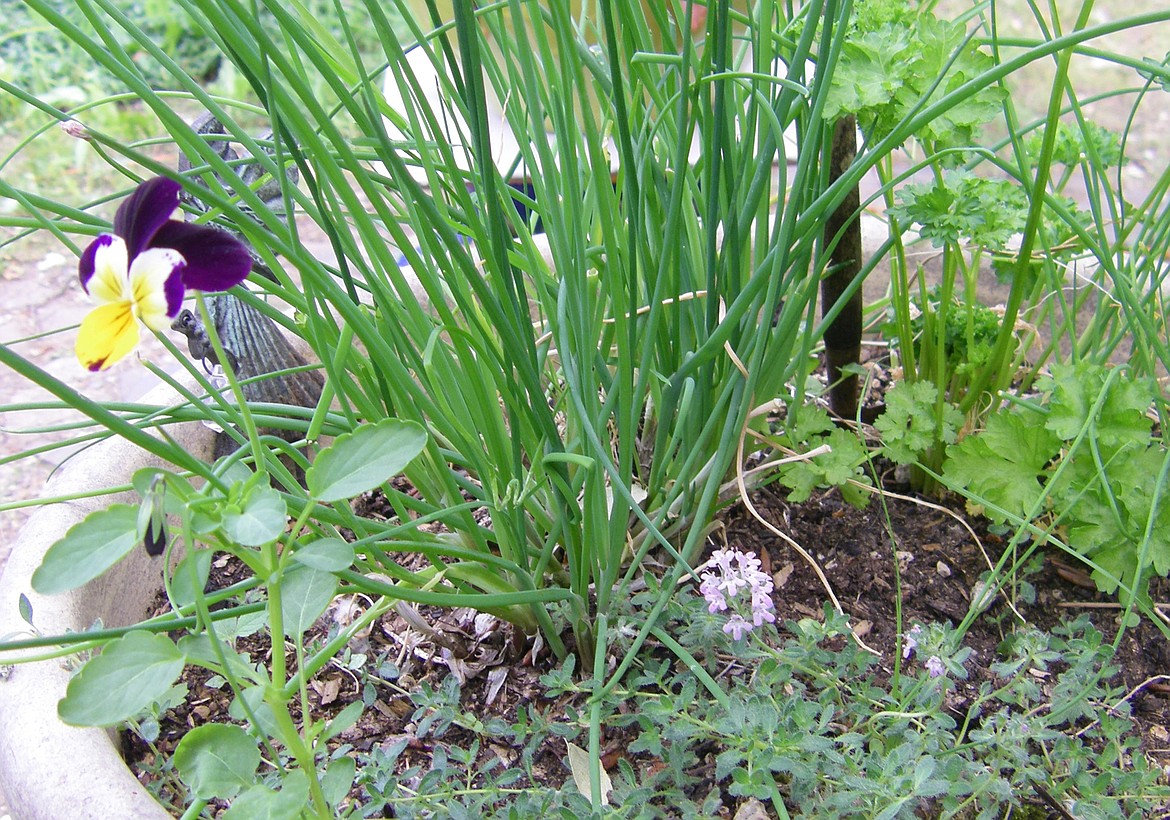‘Pot’ gardens are champions of versatility
What’s in a name? If a box can be a potager – then that’s what it is. So it was that when I recently decided to put my huge pots to use as “kitchen gardens,” it came to me that the planter didn’t actually have to be a “pot.” In fact a few weeks ago, I touted using large (appropriate) rocks as containers. Use what you have and the results are often rewarding.
However, I happen to have a goodly collection of beautiful, heavy-duty ceramic pots, but almost any soil-holding item can be a planter – think of spuds in old tires!
My pots are a practical and attractive answer for most anything that grows, from small herb plants to tall, climbing or “shrubby” edibles. Tomatoes, peppers, eggplant, blueberries, rhubarb are eminently pot-worthy , as are fruit-bearer/ornamentals such as raspberry-blackberry bushes and a plethora of flowers, even dwarf fruit trees. These include peaches, plums, cherries and apricots. There’s an enormous variety of choices for these small trees that range from those setting actual fruit such as the weeping cherry. Many do not set fruit, but blossom beautifully for the benefit of bees, hummingbirds and other pollinators.
For best results with pots, place them (preferably on gravel), fill the bottom 1/4th with small rocks followed with a bag of ordinary garden soil and topped with the best planting soil available. Fill your container to a few inches below the rim. For ornamental beauty your big pots can host everything from Hydrangea, Lavender, Dwarf Roses, and countless other options. If you’re too busy to really garden, take the “high road” with big pots – or boxes or deep wheelbarrows, etc., for beauty and ease of care. By the way, if you’re purchasing new containers, don’t buy plastic pots! Invest in good, heavy-duty ceramic pots with a drain hole, and allow Nature to take her course with rain and sunshine.
•••
On now, to our beloved spring birds: Of course, at this writing there’s been no spring, just the endless winter that started right after the fire season’s following rains last fall.
The all-season chickadees and Nuthatches, though few in number have been joined by the lovely Towhees – only four or five, and a surprise gathering of a dozen or so Song Sparrows – first-timers here, and the main flock on site. “My” old Robin stuck around through the whole miserable winter, as did various woodpeckers. Two tiny, brave Rufous Humming birds have control over the nectar feeder and aside from the threatening crow pair, pretty much make up the rather sparse bird population.
My feeders hang from just inside the porch roof eaves and are pretty much still the best way to go. Raccoons – and the occasional skunk - can’t climb porch posts or hang from rafters and while they will avail themselves of spilled seeds on the porch or deck floor, that’s all they’re going to get. There are other advantages to such locations – out of the rain or snow, away from bully birds like crows and easier replenishing as well.
A few years ago, a problem with salmonella in bird feeders was reported and the suggestion I gave at that time still holds. Do not use wooden, plastic, or other solid-floored feeders. Protected or not, moisture gathers at the bottom to create mold and encourage disease. For several years I have used small loose-woven baskets with handles for my feeders and with their better air circulation have never given me a problem. Also, I don’t fill feeders to the brim, putting out small amounts and replenishing through the day. Each morning before re-filling, I toss any seeds remaining in the baskets onto the ground for ground feeders and make sure the inside base is dry. A plus to this practical solution is that baskets look pretty – and a second (adorable) plus is that chickadees and nuthatches look so cute clinging to the sides of the baskets and pulling seeds out through the weave.
Sadly, the challenges faced today by the poisons of Monsanto, Bayer’s Neonics and habitat-loss by burgeoning human expansion, along with other considerations, continue the horrendous decimation of bird-life that includes songbirds, water-birds and other migrators and further south, ground-dwellers (burrowing owls, Cactus wrens, Prairie chickens, Sage hens, etc.), we must all do our best to keep what birdlife we are blessed with and hopefully, lure others to our welcoming feeders/shelters.
Happy gardening – Happy bird-watching – and here’s health and love to you all. At 92, it’s time to get a little rest, and maybe from time to time put my two-cents-worth in on matters of concern. Doc says my brain, heart and lungs are all great – (we won’t mention the bilious belly) – and I’m truly a happy, lucky person. If you drive by, and I’m out there tossing black oil sunflower seed to the turkeys, maybe repotting a plant – give me a toot and a wave! It’s been a pleasure and a joy.
XXXX, Valle.
Valle Novak writes the Country Chef and Weekend Gardener columns for the Daily Bee.

